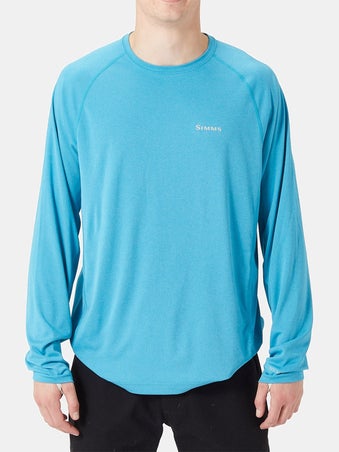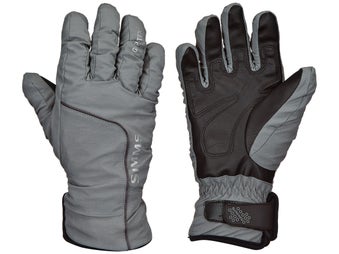2017 BASS Winning Pattern Baits & Gear
John Cox Wins Chickamauga BASS Open
"If I had to pick anywhere to fish a Classic, that would be the place," he said. "I've seen it in a lot of different stages and it feels like home there. "It fishes so big and everybody can spread out - it's almost like you can get lost. And you can do your own thing because there's so many pattern options." Cox went to Chickamauga hoping he could get away with doing little other than looking at fish in extremely shallow water and trying to entice them to bite. "I really enjoy sight-fishing and I was figuring this was probably the last tournament of the year where I'd be doing a lot of it, so I at least wanted to go and enjoy it and catch some big ones," he said. He waypointed a good number of fish during practice that were in excess of 4 pounds, but then the water level rose about 2 1/2 feet prior to day 1 of competition. That made his task more difficult in one respect (the fish were harder to visually locate), but easier in another (he had less competition for the bed-dwellers). "When the water came up and people couldn't see those fish anymore, a lot of them just gave up on sight-fishing."
Competition:
The fish Cox had marked in practice included three in the 8- to 9-pound class, but by the first competition day the water had gotten much too high to determine whether they were still there. He could find only five of the spawners he'd pinpointed. "Luckily, they were five good ones," he said. He started day 2 in 5th place, just over three pounds off the pace set by Hunter Shryock. He came back with a bag that was identical to the one Shryock had weighed the previous day and took over the lead for good. That stringer was anchored by a 9-pounder that ended up being the only fish he took to the scale that he wasn't looking at when it bit. He also believes it was one of only two females he weighed in - the others were all chunky nest-guarding males. He'd spied the bruiser near a piece of wood, but it had quickly swum out of sight, and he decided to go back and make a few blind casts to where it'd been just before departing the area. He picked up a spinning outfit with 8-pound line and pitched a Senko to the stick-up, and almost immediately his line started moving away. "The next thing I know, it's got my line out past the blood knot and into my backing," he said. "And then it jumped like a tarpon - it was the scariest fish-catch of my entire life." He eventually got it close to the boat, but the ordeal was far from over.
"If it'd been an FLW Tour event I could've netted that fish 10 times, but you can't use a net in B.A.S.S. events. When it was finally (exhausted) I tried to ease it over and grab it and it was like dragging a log through the water, there was so much resistance. "When I finally got it in I was having chest pains and I had to take three or four Advil. I felt sick." Later that day he found two good fish within a short distance of each other that he could start the final day on. He pulled in the next morning and went to the one that was slightly bigger, and Shryock immediately sat down on the other one. Cox caught his fairly quickly and left to search for more. He recalled a pocket he'd visited in practice that had been inundated with mud and he decided to go back and see if it had cleared up. It had, and he quickly found a bed that contained a 3 1/2-pound male and a female that was close to 5. He had no trouble catching the male, but its mate was another matter. She was skittish and kept swimming away, and wouldn't immediately return on several occasions. After he'd worked on the fish for 75 minutes with no success, he was ready to move on. But as he was pulling up his Power-Poles, he looked down one more time and saw a tell-tale sign. "Every fish I caught acted the same, and that's not normal - they're usually all different," he said. "Almost all of them took at least 30 to 45 minutes before I got them to bite, and right before they ate they'd do this little thing with their fins and their tale. I could almost call my shot. "When I looked that last time, I saw that fish do that, so I threw back in there and she inhaled it. It was awesome!"
There was still one more adventure awaiting, however. With an hour and a half remaining in the day, he found a 3 1/2-pounder and inadvertently hooked it in the back with his first toss. He made a split-second decision to reach for his scissors and at the rod rather than bring the foul-hooked fish to the boat and then be forced to release it. He picked up another rod and threw back to it, and it consumed his offering. He got his other hook and bait back before dropping it into the livewell. He ended up with more weight than he thought he had. His final margin over runner-up Michael Neal (who also finished 2nd to him at the Cup at Lake Wheeler last summer) was a little less than three pounds. "I had no idea I had 20 pounds," he said. "I thought I might've had 18, but when I put them all in the bag, I didn't know if I even had that. I wanted to throw up. "It was Michael's home lake and after what happened at Wheeler, I thought it might be payback time."
Winning Pattern:
Cox caught all of his fish on either a Senko or a 1/2-ounce jig. "The jig is what I use around heavy cover and I'll sometimes use it to get the fish upset or get them worked up," he said. "A lot of times I'll make search casts with either the jig or the spinning stuff because it kind of gives me a break in what I'm doing."
Winning Gear:
Jig gear: 6'6" extra-fast MHX EPS90 rod, Lew's Custom Pro Speed Spool casting reel (8.3:1 ratio), 50-pound unnamed braided line, 1/2-ounce Dirty Jig (black/blue), Bitter's Daddy Jitter trailer (black/blue).
Senko gear: 7'3" medium-heavy MHX MB873 rod, same reel and line, unnamed 5/0 round-bend hook, 6" Yamamoto Senko (watermelon seed).
Spinning gear (Senko): 7' medium-action MHX High-Mod SJ842 rod, Team Lew's Pro Speed Spin reel, unnamed 8-pound fluorocarbon line.
Main factor: "I learned so much about the lake that week I was there three years ago - it helped tremendously."
Performance edge: "My boat and motor and all my equipment are set up for what I like to do, which is fishing shallow. I've got rods of different lengths and everything's customized. The people at Crestliner asked me how they could build a boat that would help me more, so they made it wider and it floats shallower. It's all been done to help me excel and take things to another level."
Chickamauga Open Winning Pattern BassFan 4/26/17 (John Johnson)
Aaron Martens' Wins Lake Champlain Bassmaster Elite Series
Brandon Palaniuk Wins the Toyota Bassmaster Texas Fest
Dustin Connell Wins BASS Ross Barnett Reservoir
Jacob Powroznik Wins Bassmaster Classic Bracket Final Match
Jacob Wheeler Wins BASS Cherokee Lake
James Elam Wins BASSMASTER Cental Open at Grand Lake
Practice:
Elam's goal for practice was to establish a game plan that he had full confidence in. "I wanted to be all-in on what I was doing," he said. "I was after five to eight keeper bites a day and there were a lot of different things on the table that could've produced that - a lot of (techniques) and a lot o places. "I had a lot of things to look at - even stuff I hadn't messed with before." Junk-fishing is often a good option at Grand during this time of year, but he didn't think that was viable last week. "A lot of times you can catch three or four on a topwater, a couple on a square-bill (crankbait) and a couple around docks. Some people caught them like that, but it wasn't as good as it can be in October. The fish were more in between - they weren't real strong on the deep structure and they weren't as far up as they're going to be probably in a couple weeks when the water gets a little cooler. "I knew I was going to have to look on the flats, the flatter points, breaks in the pea gravel and other places where they chase shad up." He eventually focused in on a handful of creeks, pockets and cuts and a few places on the main lake. The key depths were 5 to 7 feet and 10 to 15 and he enticed bites with both a topwater and a Carolina rig.
Competition:
Elam got 10 keeper bites on day 1, the most of any day during the event, but lost three good ones in brush piles. Nonetheless, he was in 3rd place with the weigh-in concluded, a pound and a half behind leader Toby Hartsell. "I didn't have to share water with anybody and nobody moved in where I was fishing," he said. "Allan Nail (the eventual 5th-place finisher) was farther back than I was in one of the creeks, but other than that I don't think I was ever close to anybody at all." He came in more than a pound and a half lighter on day 2, but moved up to the No. 2 position as Texas teenager Andy Ortega took over the lead. He faced a deficit of just 7 ounces going into the final day. A minor storm moved in on the night of day 2 and conditions were still cloudy and drizzly at take-off the next morning. The rain stopped by mid-day, followed by a change of wind direction and the appearance of the sun, and the action became painfully slow under the post-frontal conditions. Elam finished his limit just 30 minutes prior to check-in time. "The (early morning) weather was right for running around and throwing a spinnerbait and a topwater and I wanted to give that a fair shot," he said. "Later, when the sun popped out, I went back out deeper again. I ended up catching only one keeper when it was cloudy - the rest came after. "I had to stay in it mentally. I left myself an hour at the end of the day to fish one of my better places and it happened there - I caught two on the Carolina rig. I knew it would be a tough day and only two or three guys would catch a limit, and I ended up being one of them. I knew I needed a limit to give myself a shot, and it was hard."
Winning Gear:
Carolina-rig gear: 7'3" heavy-action McCain Hi-Performance Graphite Carolina Magnum rod, Shimano Metanium MGL casting reel (8.5:1 ratio), 17-pound Seaguar InvizX fluorocarbon line (main line and 2' leader), unnamed 3/4-ounce tungsten weight, 4/0 Owner Rigging Hook, bargain bin plastic lizard (green-pumpkin).
Topwater gear: Same rod and reel (7.4:1 ratio), 50-pound Seaguar Smackdown braided line, Jackall Pompadour (gill bone or black bone).
Main factor: "I did practice a little every day, leaving myself time to try new things to either eliminate stuff or find something for the next day. It just kept taking me back to what I needed to be doing."
Peformance edge: "My Phoenix/Mercury with the Power-Poles and Lowrance units. My whole boat setup is a key thing for me because it's such a peace-of-mind thing. Not having fish die is very important in the fall and I've never had one die since I've been running this setup."
BASSMASTER OPEN Grand Lake Winning Pattern BassFan 10/10/17 (John Johnson)
Jason Christie Wins BASS Lake St. Clair
Jesse Wiggins Wins Bassmaster Open Smith Lake
He won the first Bassmaster Southern Open of the year at the Harris Chain of Lakes in Florida, which qualified him for the 2018 Bassmaster Clasic;
He finished 3rd in his first Elite Series tournament at Cherokee Lake;
He competed in his first Bassmaster Classic at Lake Conroe;
He cashed checks in seven Elite Series tournaments and wound up 37th in Angler of the Year points and fourth among rookies. Suffice to say, things went way better than Wiggins anticipated and he capped it off last week with another Southern Open win, this time at his home waters of Smith Lake, where he won a Southern Open last year. His 3-day total of 39-15 was right in line with what he figured it would take to win and he wound up beating several current and former tour-level pros for this third career Open victory. He said the latest triumph is special because he got to end a special season on a high note. "The one I won last year, I knew I needed to win it in order to fish the Elites," he said. "I wasn't nervous, but more was on the line. This one was an opportunity to earn some money and end the year on a good not. I knew if I fished what I knew I'd get a couple of opportunities to catch some decent fish. I capitalized on all but one and it worked out. "I couldn't have asked for a better start and end to my rookie year. Bookending it with Open wins, it's been awesome." Wiggins, a native of Addison, Ala., says any time he competes at Smith he fishes to win.
"Any tournament there I want to win it," he said. "I get just as jacked up for a Saturday morning jackpot as I do for the Opens. I love that lake because I know I can win there." Last week, he opted to stay away from the deeper fish suspended over and around points. He knew from past experience that boat traffic and fishing pressure can spook those fish. Instead, he focused on docks and rocky banks - classic shallow patterns at Smith - and mixed in some deeper points that no one else was fishing. "It was just fall fishing," Wiggins said. "The water was down and there were not many bites to be had."
Practice:
Past experience in the fall at Smith helped Wiggins formulate his game plan for the Open. He and brother Jordan have competed in the Smith Lake Park Bass Fest tournament, held in early October. They won the tournament in 2014 and netted top-5 finishes each of the last two years. "We always did well shallow and everybody fishing deep never caught them," Wiggins said. "The boat pressure always gets to them." When he started practice last week, he tried some deep-water areas and had little to no success. "I knew not to mess with it," he said. "I didn't fish shallow in practice because I figured I'd need that for tournament. I pretty much wrote off deep stuff."
He put in three days of practice immediately before the tournament. He and Jordan shared information on what they found. Both concluded the shallow bite would trump the deep bite. "We think the exact same way on that lake," Jesse said. "In team tournaments, we both think about same the place before we talk about moving. "We have to plan out our stops so we're not fishing behind each other because I do not want to fish behind him." Their hunch was that the suspended fish would receive the most fishing pressure so they decided to focus on other options they knew once competition got started. Jesse, however, did locate one point that wasn't being fished that proved productive in the tournament. "We stayed deep to make sure that deal wasn't going on," he said. "The shallow pattern was in our back pocket. We weren't fishing to get a check. We were fishing to win. I was willing to risk getting those one or two key bites and figuring out a way to get a limit."
Competition:
When competition began last Thursday, Wiggins started his day with a decent keeper off the point he had to himself then added two more on a buzzbait. Once the sun got high enough, he threw a shaky-head around shallow docks with 2 to 7 feet of water and brush around them. He also threw a square-bill crankbait parallel to rocky, channel swing banks toward the back of a creek arm. "Just 45-degree banks with chunk rock on them," he said. He said the 80-degree water is typical for this time of year, but he still had to grind out bites. He finished the day with eight keepers and tallied 15-02. "I was very happy with that start," he added. He followed the same plan on Friday, only he waited to hit docks until about 11 a.m. It turned out to be more of a grind as he collected just six keeper bites. He fished all new water with his buzzbait - rocky banks and isolated laydowns. "Anything with shade," Wiggins said.
His afternoon cranking program saw him rely on a few stretches that held fish each day. Still, his 11-05 was enough to push him into the lead entering the final day with a 26-07 total. "I was a little disappointed," he said. "I lost two good ones that would've put me a good ways up. I still had a two-pound lead so I felt fortunate." He went out on the final day with designs on catching 17 pounds and running away with the win. He said he lost a couple more fish that would've put him in that neighborhood. "I never thought I had it won," he said. "I just wanted to catch as much as I could and let it fall where it falls." His early-morning stop on a deep point yielded two quality keepers that took some of the pressure off. "I knew I just needed to fill out a limit and I'd have a chance," he said. "That got me off to a really good start." From there, he rode his shaky-head and shallow cranking strategy to the win with 13-08 on day 3. "All three days, I kept my boat in shallower water and it worked out," he added.
Winning Gear:
Buzzbait gear: 7' medium-heavy St. Croix Avid X casting rod, Shimano Curado 70 casting reel, 50-pound Seaguar Smackdown braided line, 1/4-oz. Cumberland Pro Lures buzzbait (black and white), Zoom Horny Toad trailer (black and white).
Wiggins removed the skirt from the buzzbait and threaded on the Horny Toad.
Shaky-head gear: 7' medium-heavy St. Croix Legend Elite spinning rod, Shimano Stradic Ci4+ spinning reel, 15-pound Seaguar Smackdown braided line, 12-pound Seaguar InvizX fluorocarbon line (leader), homemade 3/16-oz. shaky-head jig, Zoom Fluke Stick (green-pumpkin).
Cranking gear: 6'10" medium-heavy St. Croix Legend Glass casting rod, Shimano Chronarch casting reel (6.4:1 ratio), 12-pound Seaguar InvizX fluorocarbon line, Jenko Fishing CD15 (flaming craw).
Wiggins swapped the stock hooks on the square-bill to #4 Owner ST-36 trebles.
The Bottom Line:
Main factor: "Just knowing the lake really well."
Performance edge: "My T-H Marine Atlas Jack Plate. I was able to run some shallow water in the back of a creek and was able to get in and out by jacking my engine up."
Notable:
Wiggins now has 16 money finishes in 21 career B.A.S.S. tournaments.
Bassmaster Open Smith Lake Winning Pattern BassFan 10/3/17 (Todd Ceisner)
John Murray Wins BASS Toledo Bend
Jordan Lee Wins Lake Conroe Bassmaster Classic
Justin Patti Wins WON BASS U.S. Open at Lake Mead
He led the event from start to finish and wound up with a 3-day total of 36.30 pounds. His final-day bag weighed just a little over 8 1/2 pounds, but it was enough to hold off a hard charge by Bassmaster Elite Series pro Brett Hite. The victory was a big dose of vindication for Patti, who led the field after day 1 last year, only to bomb on day 2 and fall out of contention. "I'm still kind of in shock," he said a day later. "You dream of winning an event like this, and when it actually happens there's such a release of endorphins and everything else. It's an emotionally draining tournament, whether you end up doing good or bad, and I'd much rather it be the good feeling. "It's pretty cool to do what I did, not necessarily to prove anything to anyone else, but to prove to myself that I've got what it takes."
Practice:
Due to work and family commitments, Patti put in only a day and a half of practice for the tournament. That wasn't a big hindrance, though, due to his vast experience on the lake and having been there just a few weeks prior for a Wild West Bass Trail event. "I only went to two areas and made my decisions off of that," he said. "I've been there enough times over the last 8 years that I know where the bigger fish hang out and where I need to go to catch a limit." He'd planned to spend all of his first practice day in the Great Basin, but discovered that a plethora of other competitors had the same idea. He opted to refuel and run to the Overton Arm and look at some grass that had been good to him in an October derby a few years back. "I caught one that was a little over 3 pounds, and then I left. I checked some other things on the way back (to the launch in Callville Bay), but nothing else produced."
The plan for the next day was to visit the Vegas Wash, but he felt he needed to dial in the Overton bite and ran back up there. He eventually determined that a jig was his best bet. "I'd done really well on the jig in previous events in October. A lot of people try to pattern the shad bite, but I knew the bigger bites would come on the jig." He honed in on a particular type of vegetation in the 6- to 8-foot depth range. "There's grass all over the lake, but I was looking for the good crunchy stuff. I don't know the names of all of them, but there's stringy shallow grass that's dying off and I couldn't get good bites out of it. I had to go a little deeper."
Competition:
Patti started each morning of the event throwing a bladed jig in shallow water, which was a pattern that was only effective for the first 15 or 20 minutes of the day. It resulted in a couple of solid chunks on day 1 and he and his triple-A partner (the U.S. Open is a shared-weight event) had a solid limit by 8 o'clock. His initial stringer was topped by a 4.17-pounder. "That one came during a little flurry that got us close to the 14-pound mark," he said. "There was a little pocket where they were feeding and it was fast and furious for a little while." It was 9:30 on day 2 before the fifth fish went into the livewell. The biggest weighed 3.80 Ð he had a 4 1/2 hooked up, but it got off before it reached the boat.
He had a lead of almost 3 1/2 pounds to start the final day. Another competitor had reached the grass bed first (the top 10 are the last to leave the dock on day 3), but graciously departed when Patti told him he was leading the tournament and that was his primary locale. He quickly landed two keepers, but then the action ground to a halt. At 11 o'clock he decided to move and visited two nearby places over the next hour that surrendered four fish to complete the limit with one cull. "We caught eight or 10 more fish after that, but none of them helped."
Winning Pattern:
Patti said that five of his weigh-in fish bit the bladed jig, six came on either a conventional jig or a Texas-rigged plastic and the other four were caught by his partners dragging Carolina rigs. "I tried to capitalize on the (bladed jig) right away and make some key casts in that 15- to 20-minute window," he said. "After that I had to just put my head down and grind. I fished every cast super-slow and I stayed off the trolling motor as much as I could. "I let the boat sit on top of areas where we could fan-cast. I told my co-anglers they were going to get bit if they just kept that Carolina rig on the bottom and dragged it slow, and that was key to getting a limit on days 1 and 3." He didn't worry about whether his slow-moving baits were on the outside or inside edge of the grass line. "As long as the bait was coming through it and up and over, that's what mattered. Once it fell on either side was when I got those bites."
Winning Gear:
Bladed jig gear: 7'6" medium-heavy Spiralite Maverick rod, Shimano Curado casting reel, 16-pound Sunline FC Sniper fluorocarbon line, 3/8-ounce Phenix bladed jig (shad), Arizona Custom Baits ChatterBait Trailer (white ice).
Conventional jig gear: 7'4" Spiralite Defiant Series rod, same reel and line, 1/2-ounce Phenix Flipping Jig (green-pumpkin), Arizona Custom Baits Little Flapper trailer (green-pumpkin).
He also threw a Texas-rigged Yamamoto Flappin' Hawg (green-pumpkin) on a 4/0 Owner Flipping Hook with a half-ounce tungsten weight. He employed a 7'4" Spiralite Ultimate Frog rod, the same reel and 65-pound Sunline BX2 braided line.
The Bottom Line
Main factor: "I planned on having people in my area and I knew I'd have to slow down and wait for the bites. It was more of a patience deal."
Performance edge: "I'd have to say my Phoenix/Evinrude for getting me there and back Ð it was a long run and I didn't have any issues and I beat a couple other anglers to my spot because my boat was so fast. Also, the Costa sunglasses were key for seeing the grass lines and making the right cast."
Bass Open Lake Mead's Winning Pattern BassFan 10/23/17 (John Johnson)
Kevin VanDam Wins Bass St. Lawrence River Event
Mike McClelland Wins Bassmaster Open Table Rock
Ott DeFoe Wins the BASS Douglas Lake Northern Open
He caught 17-05 stringers each of the first two day and closed out his fourth career B.A.S.S. win and second Open triumph at Douglas with a 15-09 bag on Saturday to finish with 50-03. He won by nearly 10 1/2 pounds. No other angler cracked the 40-pound mark. "It was the culmination of a plan coming together," DeFoe said. "I was going to fish out of my aluminum boat regardless if we had a flood or no rain for six months. When we laid out the schedule, I decided my big rig would stay in Detroit and I left the tackle I'd need at home. The plan was set in stone." Executing that plan went about as well as he could've hoped. Once he reached his preferred areas, he relied on a jig and flipped at wood targets near the water's edge before backing off a bit as the water receded on the final day. Here are some more details about DeFoe's Douglas Lake rout.
Practice:
Douglas has become a regular stop for the Opens in recent years, but DeFoe said he'd never competed there in the fall with the water drawn down. "They pull it down 40 feet vertically so fishing that lake 10 feet low is different from 15 or 20 feet low," he said. "It's not big to begin with so there's not a lot of water to offer. Every foot makes it a different lake." Therefore, he needed a different kind of boat to get where he wanted to go. He had sold his previous aluminum boat back in May. His new one and all the accessories arrived in June. That gave him little time to get the fabrication work done and rig it and test it with the Elite Series season ongoing. "I'd only had the boat at home for a month and of that month, I was only home a couple weeks," he said. Among the changes/upgrades DeFoe made to the boat were: Custom tunnel hull by Mike Watson Welding; Two jack plates (one CMC Marine Products and a T-H Marine Atlas Micro). The Micro bolted to the rear of the CMC gave him 10 inches of vertical travel; Custom rod box up front. "I'd rather have that and just throw my tackle in a bag on the floor," DeFoe said. Expanded livewell and added T-H Marine switches for livewell pump control.
DeFoe's practice consisted of time spent checking out new water - some he'd never fished before - and no time spent where he ultimately fished during the competition days. "I went out the Friday before (Labor Day) with a friend and we fished some bass boat water," he said. "We caught a couple, but we were in water anybody could get to. Then we went further than where I've ever gone up the river. We went to look for anything I wanted to add to other places I'd planned to fish. I caught small ones, but nothing to speak of." He took the next four days off and when he was back on the water last Wednesday, it was mostly to check the water clarity after the area received a good bit of rain the previous day. He made one cast all day. "Some of it had muddied up and some hadn't changed," he added. "The French Broad can be hard when it's rained. I went up the Nolachuckie, but that place is a boat eater and I didn't find anything worth going back to. "What few casts I made between Friday and the tournament were in places I had no intentions on fishing anywhere in the tournament." The pre-tournament rain wasn't what DeFoe wanted to see. He knew he had an advantage in reaching areas of the river others couldn't in fiberglass boats. Any rise in water levels could negate that edge. "That's the last thing I wanted to happen because when I'm fun fishing in the fall I like it to be clear and the only way it gets clear is when it gets low," he said. "When it's low, half of those other guys are taken out of the equation. "Mike (Watson) and my boat and Skylar (Hamilton's) boats were set up right to do it, but Mike and I are just dumb enough to do it. If four boats were up there, that would split the fish up a lot over three days."
Competition:
On Thursday, DeFoe made the 45-minute (20 to 25 miles) run up the French Broad and came up empty at his first spot. His confidence never wavered, though, even after losing a 3-plus pounder at his second spot. He caught four in quick succession then finished his limit with a 4 1/2-pounder. "It didn't take long to be like, 'I know what I'm doing,'" he said. "I guess not coming to practice wasn't a bad decision." He expected to get more bites overall than he did and he's not sure what to attribute that to. Local fishing pressure, possibly. "I do know there was a lot of fishing line in those trees up there," he noted. His 17-05 stringer gave him a 12-ounce lead over Watson, who hails from Bluff City, Tenn. The jig was a big factor on day 2 as it produced all of his weigh-in fish. He did notice the water starting to fall and clear up.
"I had my bag pretty early and laid off," he said. "I caught 'em while it was still up." Another 17-05 sent him into the final day with a 3-plus pound lead over fellow Elite Series angler Drew Benton and based on his knowledge of the area, he figured Saturday would be the best fishing day of the tournament. "Usually the third day after it quits raining is good," he said. "Typically, if it rains on a Monday, you let it sit Tuesday and Wednesday and go out on Thursday, it'll be good times. It had rained Tuesday and it sat Wednesday through Friday. I figured the water would be just right on Saturday." Instead, it had fallen and wound up being just a bad fishing day all around. Even those who stayed on the lake didn't have good days. There were only two limits caught on day 3 that weighed more than 10 pounds. "I was surprised it wasn't any better on day 3," DeFoe said. "I only caught five keepers and lost two. The water got dirtier during the day Thursday and was rising. On Friday, it evened out and cleared a touch. It went from 4 inches of visibility Thursday to maybe 8 inches on Saturday. By then, the fish get accustomed to the water color. It was just a hard day. I think the pressure had gotten to them some. "A lot of times the dropping water would pull the fish out a little. On day 3, it backed them off and I had to adjust a little and reposition my cast more than anything."
Winning Gear:
Jig gear: 7'6" heavy-action casting rod, casting reel (8.3:1 ratio), 20-pound fluorocarbon line, 1/2-oz. Terminator Pro Series jig (black/blue/chartreuse), Chunk (green-pumpkin blue flake).
He also caught keepers on a vibrating jig, a spinnerbait, a swimbait and flipping a beaver style bait.
Main factor: "Knowledge. In the month of September, I've spent countless hours up there in the last 15 years - and a lot of them have stunk. I've either been out of my boat pushing it around or learning and looking over every inch of water when it's up or down, clear and muddy. Hands down the knowledge of that water and knowing when it comes up they do this or comes down they do that."
Performance edge: "Obviously, the boat was number one, but the (Minn Kota) Ultrex and that little Mercury 60. I'm running a 250 on the big boat and so were 90 percent of the other guys in the field. I had 190 fewer horsepower than most people in the event, but the cool thing was for a 90-minute to hour and 45-minute round trip, I was burning nine gallons of gas. It's a cool little motor and has a lot of power for being so small."
DeFoe is well aware his victory has opened the door for another Elite Series angler to qualify for next year's Bassmaster Classic. He joked about the compensation he hopes to collect this week at the Angler of the Year Championship. "Somebody owes me a steak dinner this week," he quipped. He's a lock for the Classic by virtue of his 5th-place standing in points. His goal this week to hold steady and not lose any ground. "I want to have a solid week here," he said. "Points wise I can't move up a whole lot, but I can drop a few. I can't win AOY, but I can lose money so I want to hold steady because that AOY payout is pretty stout. Plus, a top-5 just sounds better than sixth place."
BASS Northern Open Douglas Lake Winning Pattern BassFan 9/12/17 (Todd Ceisner)
Rick Morris Wins BASS Northern Open at James River
Morris put in 6 full days of practice for the Open, spending all but 1 of them in the Chick. "Tidal fishing is complicated and I needed a refresher course," he said. "I fished a lot of places I knew, and then I fished them again on different tides. "I already knew the run to the Chick (from the launch site in Richmond, Va.) and I knew a lot of places to fish on my way back, although I never caught a fish on any of those stops (during the tournament)." He said the largemouths in the James are often referred to as being Florida-strain, but they're actually the F1 hybrid (a cross between the Florida and northern strains designed to obtain the former's growth potential and the latter's aggressiveness). One of their Florida traits was on display last week. "They were really, really finicky most of the time. In Florida, the big ones won't bite when a front comes through, and these fish are like that when they get a little stressed from pressure and heat. "When the tide was just right they'd go on feeding flurries, but most of the time they weren't aggressive. They'd just peck, peck, peck the bait or barely pick it up."
Competition:
Morris' program for the tournament included both power-fishing and finesse tactics. He spent a lot of time throwing a worm on spinning tackle, but also pitched a spinnerbait along outside bends in creek channels that featured deeper water and current, and threw a jig around duck blinds and sunken ships and barges. He caught a decent bag on day 1, a good one on day 2 and a massive sack (considering the circumstances) on day 3. He said the biggest factors in his final-day haul were having only 11 fellow competitors on the water with him (the original field was 158) and the apparent late start of a local tournament. "With only 12 guys, I could really stretch out and hit a few things I hadn't hit yet. Once I had a limit with a good, solid 3 1/2-pounder, I started running isolated covers that I knew and I caught a 6-pounder and a 4. "I think by the time the local tournament blasted off, I was already fishing, so I was lucky they were slow to get out. Also, it was a small tournament - if it had been 100 boats, that would've wiped me out. I wasn't fishing secret stuff - the locals know where all of it is." He used a Texas-rigged worm to pull the 6-pounder from a duck blind at about 11 o'clock. The 4, which came a bit later, was sitting next to a cypress tree that had current washing up against its trunk. That cull resulted in a 2-pound upgrade and provided his winning margin over runner-up Hamilton Jefferson. "That's where past knowledge really helps," he said of the second oversized bite. "I know a lot of subtle places that are often holding a good fish."
Winning Gear:
Worm gear: 6'10" RPM Custom Rods Dropshot Special spinning rod, Team Lew's Pro Speed Spin reel, 20-pound Gamma braided line (main line), 12-pound Gamma Edge fluorocarbon (leader), unnamed 1/8-ounce weight, unnamed 3/0 hook, various worms, all featuring a bluish tint to imitate the river's population of blue crabs.
Spinnerbait gear: 7'11" heavy-action RPM Custom Rods Okeechobee Special rod, Lew's BB1 Pro Speed Spool casting reel (7.1:1 ratio), 20-pound Gamma fluorocarbon, 3/4-ounce War Eagle spinnerbait (silver shiner).
Jig gear: Same rod and reel as spinnerbait, 60-pound Gamma braid 1/2-ounce War Eagle jig (green-pumpkin/brown), Strike King Rage Craw trailer (green-pumpkin).
Main factor: "All the extra practice I put in only on the bottom of the Chick. I was only burning like 3 or 4 gallons of fuel in 10 hours."
Performance edge: "I was fishing some brush and the Lowrance Side Scan made a huge difference. Also, I needed the Power-Poles to hold the boat in the current so I could throw to the same place over and over and over. They're an absolute must in tidal water."
James River BASSMASTER Open Winning Pattern BassFan 8/8/17 (John Johnson)




































































































































































